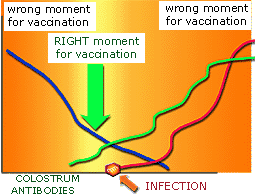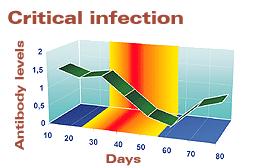| Chapter 5. How are immunoglobulins studied? | | | | | | | What are the practical applications of serum profiles? | Serological studies in piggeries are mainly used to: Prevent the entry of diseases in replacement animals. Choose the most suitable time for vaccination in the piggery. Monitor the vaccination programmes, as well as find out the health status of the piggery.
| | | | |
| MAIN APPLICATIONS OF SERUM PROFILES |
|
Prevention of the entry of diseases. |
 |
|
Choosing when to vaccinate. |
 |
|
Monitoring a vaccination programme. |
 |
|
Finding out the health status. |
 |
|
Serological surveillance of areas. |
 |
|
Protection indicators. |
 |
|
Prevention of the entry of diseases.
Preventing the entry of diseases into the piggery is one of the issues which can be addressed by serology. One of the main routes by which diseases enter a piggery is by the arrival of new animals which have not undergone quarantine or serological analysis. The first step to prevent infections in a piggery is to avoid bringing in sick animals and/or carriers of diseases. Studying the serum of an animal before it comes into contact with existing animals prevents the piggery from being contaminated and avoids significant financial losses. It is advisable to know the serological condition of the farm of origin, as well as imposing a quarantine period of 4 to 8 weeks, depending on the disease to be kept under control. It should be remembered that every infectious disease has an incubation and elimination period which varies considerably.
|
|
 At the ideal time for vaccination (yellow area) the maternal antibodies do not interfere with vaccination, but are still protective (blue line). This situation enables vaccination antibodies (green line) to develop, preventing infection and the subsequent appearance of infection antibodies.
At the ideal time for vaccination (yellow area) the maternal antibodies do not interfere with vaccination, but are still protective (blue line). This situation enables vaccination antibodies (green line) to develop, preventing infection and the subsequent appearance of infection antibodies. |
A single determination on the arrival day of the animals is not sufficient to find out the health status of the animal. They could be in a period of incubation or starting the infection and obtaining negative results. Therefore a good period of quarantine is important, dedicating the time necessary to allow any disease to be expressed clinically and/or serologically. Studies of whether antibodies against different diseases are present during quarantine, allow us to find out the health status of the animal before bringing it into the piggery.
. 
Model showing the development of maternal antibodies and appearance of infection antibodies (after 60 days) in A.D. The critical area of infection can be observed; this is normally from 35 to 40 days |

|
|
Monitoring a vaccination programme.
In this study, serum is taken from different piglets on different days after birth, from day 0 until day 40. This establishes the immune condition of the piglets and the point at which they present the lowest level of antibodies. Therefore the best time for vaccination can be calculated. Another way of establishing the serum profile of the piglets is to select a number of piglets from different litters. Their antibodies against the disease under investigation are studied on different days from 0 to 40, but in this case, the same animals are always studied.
It must be remembered that serological profiles serve to find out the health situation during productive conditions of the study. If any of these parameters were to change (different vaccine, age of vaccination, different animals, etc) the result of the profiles could also change. Therefore, serological studies should be performed every time changes are made in the piggery.

|
Vaccines are important weapons to prevent the spread of diseases and to keep the immune system stimulated. However, for them to be truly effective they should be used correctly.

|
|
Finding out the health status.
Another application of serology is to discover whether infectious diseases are present and their development in a particular piggery. Finding out the health status of our piggery should be one of the main objectives in order to increase quality and reduce production costs. Therefore serological studies, alongside inspections at the slaughterhouse and even monitoring with sentinel animals and their subsequent serological evaluation, are good study tools. Nevertheless, to carry out these epidemiological surveillance studies, it must be remembered that antibodies take time to appear and can be detected using conventional techniques. This time varies from 10 to 30 days, so therefore serology is not the most suitable technique for the early diagnosis of an infection, as it could occur that all the samples are negative as the animals are between the incubation period and the disease being incubated.
Serology is more useful for the detection of a latent or chronic situation than for an acute situation. To study the presence of a particular disease in the piggery, two determinations of the same animal should be taken with a difference of around 20 days. This is true in all cases, except in Aujeszky disease in which a sick animal or carrier can be distinguished from a vaccinated animal thanks to the gE negative vaccines currently used, and the situation therefore detected in just one determination.
|
|
A single determination on the arrival day of the animals is not sufficient to find out the health status of the animal. They could be in a period of incubation or starting the infection and obtaining negative results. Therefore a good period of quarantine is important, dedicating the time necessary to allow any disease to be expressed clinically and/or serologically. Studies of whether antibodies against different diseases are present during quarantine, allow us to find out the health status of the animal before bringing it into the piggery.
Thanks to the use of gE negative vaccines and indirect competitive ELISA methods for the assessment of anti gE and gB antibodies, in Aujeszky disease it can be detected with a single determination whether a serum corresponds to an animal which is (1) vaccinated (only has anti gB antibodies), (2) infected (has anti gB and anti gE antibodies), (3) does not have the disease and is non-vaccinated (does not have antibodies against either gE or gB).
 |
|
In other cases, without the availability of marked vaccines, determinations should be performed using the same animal with intervals of three or four weeks, and the antibody titer obtained in each determination assessed. In these studies the positive or negative result is not relevant; the aim is to find out the titer (level of antibodies) obtained in each determination. Therefore, we can achieve an accurate picture of the situation of infectious diseases which could affect the piggery.
After obtaining the results of both determinations the following can happen: |
|
 |
|
SERONEGATIVIZATION |
|
 |
|
SEROCONVERSION |
|
 |
|
BASAL CONDITION |
-
That the titer of the first determination is greater than that of the second. In this case the animal would be recovering from a past infection (always given that it has not been vaccinated). Seronegativization.
-
That the titer of the first determination is less to that of the second. The animal would be in an acute infection process where the immune system is responding adequately. Seroconversion.
-
That both determinations obtain similar titers. In this case it is a basal response and depending on which disease has been studied the animal could be a possible carrier. (basal condition)
In conclusion, using this type of studies it can be discovered if the animal is beginning or ending an acute phase of a particular infection, if it is a carrier of the latter, or if it is in a recuperation period.

Serological surveillance of areas
Equally, serology is indicated to find out the health status of an area which has been affected by a particular disease and whether it is necessary to recommend the raising of the restrictions on movement of animals. For this type of studies, serological analysis is carried out in the different piggeries in the area, usually starting 30 days after the last case. If the serology is negative the restrictions are lifted.

|
|
Protection indicators.
As we will see in chapter 7, the degree of real "in vivo" protection against a particular infectious agent is conditioned to the capacity of the humoral and cell response of a particular animal. Therefore, exclusively humoral assessment does not provide particularly safe data, above all in negative cases. In other words, when there is a low humoral response, it does not necessarily mean that the animal is not protected. Nevertheless, the evaluation of the humoral response and in particular the evaluation of the neutralizing antibodies are indicative of the protection capacity against a particular infectious agent. Serum neutralization is the technique of choice to evaluate an animal's level of protection. Nevertheless, the evaluation of specific antibodies by other serological methods can indicate an animal’s degree of protection, but its correlation is lower than that obtained by serum neutralization.
In the serum neutralization technique, the capacity of the test serum (at different dilutions) to neutralize the infectivity of a virus is evaluated on a sensitive cell line. If the unknown antibody neutralizes the virus, there will be no viral replication (absence of cytopathic effect). If it does not neutralize it, there will be viral replication (cytopathic effect). In viruses which do not produce a cytopathic effect, possible viral replication is observed by techniques of immunofluorescence or peroxidase.

|
|
OTHER APPLICATIONS OF SEROLOGY.
Serology is also used for the study of blood groups using haemolysis techniques. Fifteen blood group systems have been described in pigs. These are identified with letters from A to O, with group A being the most abundant. A and O are soluble antigens found in the serum of pigs and which bind to the erythrocytes of each animal after birth. There are also anti-A antibodies. If an A negative pig has these antibodies and receives a transfusion from an A positive animal, a transitory collapse with haemoglobinuria will occur.
The blood groups are regulated under the control of two loci. One, called locus A, contains two alleles: A and O. The other, known as S locus (secretor), also has two alleles: the S and a recessive allele known as s. The S locus controls the expression of the A system, meaning that only A or O will be expressed if the animal has a recessive s gene.
The genotypes identified up to now are:
Different combinations of animals have been identified from these genotypes. These are:
|
Combinations of A positive erythrocytes:
AASS, AASs, AOSS, AOSs |
|
O positive erythrocytes:
OOSS, OOSs |
|
A and O negative erythrocytes:
Aass, OOSS, Ooss. |
|
|
| |

